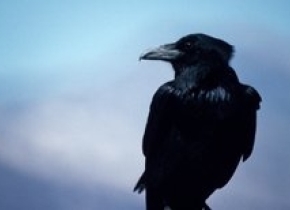
乌鸦的鸣叫带有个体特征
基于年龄和性别,乌鸦能发出不同类型的叫声,这可能有助于乌鸦评估其他个体的大小。
撰文/播音 Jason G. Goldman 詹森·G·古德曼
翻译 张心茹
审校 张清越
There's a well-known conspiracy of ravens—that's what you call a group of ravens—that likes to hang out near a zoo in the Austrian Alps. Every day these ravens conspire to steal the food that's set out for the wild boars there.
乌鸦有一个众所周知的“阴谋”---那就是所谓的一群乌鸦,喜欢在奥地利阿尔卑斯山的一个动物园附近闲逛。这些乌鸦每天都会窃取那里为野猪准备的食物。
"So we have a really great opportunity to really watch those individuals daily. "
“所以给我们每天观察这些个体提供了一个好机会。”
University of Vienna cognitive biologist Markus Boeckle. He spends lots of time ignoring the zoo animals and watching the ravens.
维也纳大学认知生物学家马尔库斯·博埃克Markus Boeckle说,他花了很多时间来观察乌鸦,而完全忽略了园里的动物。
"And what we found is that every time they come they do those food calls, which is very typical for the ravens when they are close to potentially dangerous food resources."
“我们发现,每次它们来时,都会发出表示食物的鸣叫,这是它们靠近潜在危险食物来源时发出的典型叫声。
[Raven haa call sounds]
The ravens use these calls to recruit their buddies to show up, both to reduce potential dangers from predators and to overpower dominant ravens who might be trying to hoard all the food for themselves.
乌鸦利用这些叫声招引它们的伙伴出现,既能减少来自掠食者的潜在危险,又能压制那些可能将食物据为己有的优势个体。
But Boeckle and his colleagues began to suspect the calls revealed other information.
但博埃克和他的同事开始怀疑,这些叫声还包含着其他信息。
"So we had the feeling we could say, this is a juvenile, this is a sub-adult, and this is most probably an adult, just by listening to the calls."
“所以我们有了一种仅仅通过听叫声就可以分辨乌鸦年龄的感觉,不管这只(乌鸦)是少年,即将成年,还是很可能已经成年。”
If the researchers could use the calls to distinguish among ravens, then perhaps the ravens themselves could do so too. So Boeckle and his team recorded the calls of around a hundred known individuals—all of which had previously been catalogued by weight, age and sex and were identifiable by colored leg bands.
如果研究人员可以使用这些叫声来区分乌鸦,那么乌鸦自己也可以这样做。所以博埃克和他的团队记录了大约一百个已知个体的叫声,所有个体的重量,年龄和性别都曾被收录,并且可以通过彩色腿带识别。
The researchers combined that data with the acoustic properties of their calls and dumped everything into a computer program. And as they suspected, there were differences in the frequency, duration, and amplitude of the calls that could sort the ravens according to sex and age. The results were published in the journal Frontiers in Zoology. [Markus Boeckle et al., Raven food calls indicate sender's age and sex.]
研究人员将这些数据与其叫声的声学特性相结合,并将所有内容都输入了计算机程序。正如他们所怀疑的那样,根据性别和年龄的不同,呼叫的频率,持续时间和振幅有所不同。这些结果被发表在“动物学前沿”杂志上。 [Markus Boeckle et al., Raven food calls indicate sender's age and sex.]
"So the benefit is, especially for birds like ravens who travel long distances every day, that whenever you encounter a new individual, or listen to a new individual, you are already able to categorize one of the birds just based on the calls…. So this really helps to assess whether you're going to be in an aggressive situation or whether you're going to be the more dominant individual, just by listening to the call."
“所以,对特别是像乌鸦这样每天都要长途跋涉的鸟类,(这个现象的)好处是无论遇到新个体还是听新个体的声音,你都可以根据叫声对其中一只进行分类。所以这确实有助于仅仅通过叫声评估你是否要处于进攻状态,或者你是否会成为更具优势的个体。”
To be clear, the researchers showed that they could categorize ravens according to their calls, not that ravens actually do so. That's what Boeckle and his team are working on now.
有一点需要澄清,研究人员只是说明,他们可以根据乌鸦叫声对其分类,而非证明了乌鸦实际为之。后者是博埃克和他的团队现在正在开展的工作。
Still, the study shows that while a call can primarily refer to some external object, like food, it can also transmit additional social information. And since these sorts of calls are thought of as the precursors for language, this study might shed light on how a simple system for communication can evolve into something far more complex—such as me talking to you now.
尽管如此,研究表明,虽然叫声主要标示着某种外物,如食物,但它也可以传达额外的社交信息。而且,由于这些类型的叫声被认为是语言的前身,本研究可能会阐明,一个简单的沟通系统如何演变成更复杂的事物 , 比如现在我与你正在进行的对话。
未经书面许可任何人不得复制或镜像
京ICP备11000850号
 京公网安备11010502039775号
京公网安备11010502039775号 信息网络传播视听节目许可证0111611号
国家科技基础条件平台

















